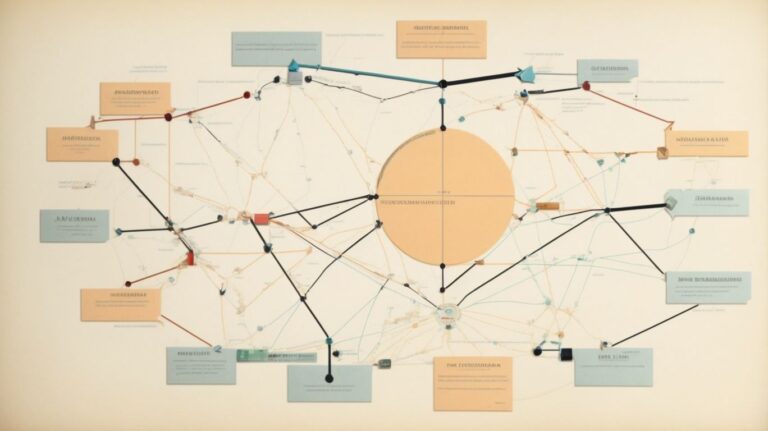Have you ever found yourself stuck in a cycle of behavior that seems impossible to break? This phenomenon, known as the Ratchet Effect, sheds light on the reasons behind our persistence in negative behaviors and the difficulty in changing our mindset.
In this article, we will explore the causes and effects of the Ratchet Effect, as well as how to prevent it from taking hold in our lives. From political polarization to toxic relationships, real-life examples will illustrate the power of this psychological concept.
Contents
- 1 What Is The Ratchet Effect?
- 2 What Are The Causes Of The Ratchet Effect?
- 3 How Does The Ratchet Effect Work?
- 4 What Are The Effects Of The Ratchet Effect?
- 5 How Can The Ratchet Effect Be Prevented?
- 6 Examples Of The Ratchet Effect In Real Life
- 7 Frequently Asked Questions
- 7.1 What is the Ratchet Effect in psychology?
- 7.2 How does the Ratchet Effect relate to persistence in psychology?
- 7.3 Can the Ratchet Effect also lead to escalation of behaviors?
- 7.4 What are some examples of the Ratchet Effect in psychology?
- 7.5 How can understanding the Ratchet Effect be beneficial in therapy?
- 7.6 Is the Ratchet Effect always negative?
What Is The Ratchet Effect?
The Ratchet Effect, a concept often observed in various human processes, refers to a situation where changes or advancements in a system, once implemented, become difficult or impossible to reverse.
This phenomenon can occur in a variety of scenarios, from social policies and organizational structures to technological developments. Once a change is made, it locks in, making it challenging to go back to the previous state. The Ratchet Effect can be seen in governmental regulations, where new rules accumulate over time, making it hard to simplify the system. Similarly, in technology, once a feature is added to a product, it becomes expected by users, setting a new standard. This effect can lead to incremental changes that accumulate over time.
What Are The Causes Of The Ratchet Effect?
The causes of the Ratchet Effect are often rooted in cognitive dissonance, groupthink, and social comparison theory, which contribute to the perpetuation of incremental changes without easy reversibility.
Cognitive dissonance plays a significant role in the Ratchet Effect as individuals tend to seek consistency in their beliefs and actions, even if it means justifying behaviors that are contrary to their initial values.
Moreover, groupthink amplifies this phenomenon, as individuals within a group prioritize harmony and conformity over critical evaluation of decisions, leading to a collective acceptance of suboptimal choices.
Similarly, the social comparison theory further fuels the Ratchet Effect by prompting individuals to compare themselves to others, influencing their decisions to keep up with perceived societal norms or group standards.
Cognitive Dissonance
Cognitive dissonance plays a significant role in fueling the Ratchet Effect, as individuals tend to rationalize and justify their decisions even when faced with conflicting information or beliefs.
This phenomenon of cognitive dissonance can be observed in various aspects of daily life, from personal choices to organizational decision-making processes. When individuals experience conflicting thoughts or beliefs, they often seek consistency by adjusting their attitudes or behaviors.
- For instance, a person who is aware of the harmful effects of smoking but continues to smoke may engage in cognitive dissonance by downplaying the risks or ignoring contrary evidence.
- Similarly, in business settings, employees may rationalize unethical practices to align with their actions, leading to a perpetuation of misconduct within the organization.
This tendency to reduce dissonance by justifying decisions ultimately contributes to the reinforcement of the Ratchet Effect, where incremental deviations from ethical behavior become normalized over time.
Groupthink
Groupthink contributes to the escalation of the Ratchet Effect as cohesive groups prioritize consensus and conformity over critical evaluation and alternative perspectives, leading to incremental changes without reversibility.
Within organizational contexts, groupthink can be particularly dangerous as it stifles dissenting opinions and discourages individual creativity, resulting in decisions that lack thorough consideration.
Group members may feel pressure to conform to the dominant opinions to maintain harmony, inadvertently amplifying the Ratchet Effect by anchoring on past decisions rather than exploring new possibilities.
Case studies such as the Challenger space shuttle disaster underscore how groupthink can override warning signs and suppress dissenting voices, ultimately leading to catastrophic outcomes.
Social Comparison Theory
Social comparison theory influences the Ratchet Effect by driving individuals or groups to maintain or surpass perceived benchmarks or standards, leading to a continuous upward trend in behavior or decision-making.
At the core of social comparison theory is the innate human tendency to evaluate themselves by comparing their abilities and opinions to those of others. This often results in either upward or downward comparisons, influencing self-perception and behavior. In the context of the Ratchet Effect, individuals may feel pressured to continually improve or outperform others to avoid being left behind.
This perpetual cycle of comparison can create a domino effect, where each incremental improvement fuels the drive for further progression. As a result, the desire to meet or exceed established standards becomes deeply ingrained in the psyche, perpetuating the Ratchet Effect.
For instance, in a workplace setting, employees may engage in social comparisons with their colleagues regarding performance metrics or achievements. Observing a coworker’s success can motivate an individual to strive for similar accomplishments, contributing to a culture of continuous advancement within the organization.
How Does The Ratchet Effect Work?
The Ratchet Effect operates by creating a scenario where each incremental change or decision builds upon the previous one, gradually increasing the difficulty of reversing course or returning to a previous state.
For instance, in economic policy-making, small adjustments towards higher taxes or increased regulations can lead to a spiral effect where subsequent decisions align with these changes, making it challenging to roll back these measures. This phenomenon is akin to a ratchet wrench’s mechanism, where the tool allows motion in only one direction. Once a turn is made, it locks into place, making it impossible to reverse without completely releasing the mechanism. Over time, the Ratchet Effect solidifies the changes, cementing them into the system’s structure and making it harder to undo them.
What Are The Effects Of The Ratchet Effect?
The Ratchet Effect results in various effects such as the escalation of commitment, persistence in negative behaviors, and difficulty in changing mindset due to the continuous reinforcement of incremental changes.
One notable consequence of the Ratchet Effect is the escalation of commitment, where individuals tend to invest more resources, whether time, money, or effort, in a particular course of action despite diminishing returns. This phenomenon can be observed in businesses where a company continues to pour resources into a failing project to justify the prior investments made.
The persistence of negative behaviors is another outcome of the Ratchet Effect, where individuals or organizations stick to ineffective strategies or habits because they have been reinforced over time, even if they are detrimental. For example, in personal finances, individuals might continue spending recklessly even when facing mounting debts.
The challenge of altering established mindsets is a central issue linked to the Ratchet Effect. Once a pattern of behavior or decision-making is set, it becomes difficult to reverse course due to the inertia of past actions. This can be observed in political situations where leaders find it hard to shift policies, even when evidence suggests a change is necessary.
Escalation Of Commitment
The escalation of commitment is a common effect of the Ratchet Effect, where individuals or groups increase their investment in a chosen course of action despite negative outcomes or diminishing returns.
Several factors contribute to the phenomenon known as escalation of commitment. One key driver is the psychological phenomenon of cognitive dissonance, where individuals strive to maintain consistency in their beliefs and actions, leading them to justify further investment in failing strategies to reduce the discomfort of admitting failure.
- Another factor is sunk costs, where individuals consider the resources already invested as irrecoverable, pushing them to continue investing in hopes of recouping losses.
- Social pressures and reputational concerns can also play a significant role in perpetuating the escalation of commitment, as individuals may fear the consequences of abandoning a failing strategy on their credibility or status within a group.
Persistence In Negative Behaviors
The Ratchet Effect can lead to the persistence of negative behaviors, where individuals or organizations continue engaging in detrimental actions or decisions due to the reinforcement of past choices.
This phenomenon occurs when individuals are trapped in a cycle of negative behavior that escalates over time, making it difficult for them to break free from the pattern. The Ratchet Effect is fueled by various factors, such as cognitive biases, social pressures, and environmental influences, which gradually reinforce the negative actions.
One mechanism that sustains detrimental behaviors is the concept of ‘sunk costs,’ where individuals continue to invest time, resources, or effort into a failing endeavor, simply because they have already committed so much. This psychological barrier prevents individuals from objectively assessing the situation and often leads to further entrenchment in negative behaviors.
Social norms and group dynamics play a significant role in perpetuating negative behaviors. For instance, in a workplace setting, if a toxic work culture tolerates unethical practices, employees may feel compelled to conform to these behaviors to maintain their standing within the group.
Difficulty In Changing Mindset
Changing mindset becomes challenging in the presence of the Ratchet Effect as individuals or groups find it hard to deviate from established patterns or decisions, reinforcing the status quo.
Within the realm of behavioral economics, the Ratchet Effect elucidates how once a decision is made or a pattern is established, there is a tendency for subsequent choices or behaviors to be anchored to that initial point, making it difficult for change to occur. This phenomenon is deeply rooted in human psychology, where individuals often rely on past decisions or beliefs as reference points, creating resistance to adopting new perspectives or behaviors.
How Can The Ratchet Effect Be Prevented?
Preventing the Ratchet Effect involves strategies such as recognizing its presence, seeking diverse perspectives, and incorporating breaks for reflection to interrupt the cycle of irreversible escalation.
One effective method for recognizing the onset of the Ratchet Effect is to actively monitor incremental changes and observe if they are leading to disproportionate responses. By staying attentive to these subtle shifts, individuals can detect the early signs of a potential escalation. Incorporating diverse viewpoints can help in gaining a comprehensive understanding of the situation. Listening to perspectives different from one’s own can bring new insights to light and prevent tunnel vision. Taking regular breaks for reflection is crucial in breaking the momentum of the cycle. Pausing and analyzing the situation can provide the opportunity to reevaluate decisions and avoid unnecessary escalation.
To implement these prevention techniques effectively, individuals can use tools like decision-making frameworks or conflict resolution models. These resources can offer structured approaches to assess situations, gather diverse opinions, and make informed choices that prevent the Ratchet Effect from taking hold.”
Recognizing The Effect
Recognizing the Ratchet Effect involves being mindful of incremental changes that may lead to irreversible outcomes, emphasizing the importance of identifying early signs of escalation.
One aspect individuals can observe in the presence of the Ratchet Effect is the gradual increase in resources allocated to a failing project or venture, despite diminishing returns. This phenomenon reflects a sunk cost bias, wherein individuals justify further investment due to previously committed resources, even if the project is no longer viable. Escalating commitment may be evident through reinforcing feedback loops, where initial small decisions snowball into larger commitments over time.
Seeking Diverse Perspectives
Seeking diverse perspectives serves as a countermeasure to the Ratchet Effect by introducing alternative viewpoints and challenging existing norms or decisions, fostering critical evaluation and flexibility.
This infusion of different opinions not only disrupts escalating commitments, but it also enables individuals and organizations to adapt and grow. When individuals are exposed to varied perspectives, they are more likely to question assumptions, consider new possibilities, and make informed decisions.
For instance, in a team setting, members with diverse backgrounds and experiences can offer fresh insights that lead to innovative solutions and enhanced creativity. By encouraging dialogue among individuals with different viewpoints, teams can avoid getting stuck in a cycle of reinforcing past decisions blindly.
Taking Breaks And Reflecting
Taking breaks and engaging in reflection offer opportunities to pause the cycle of escalation associated with the Ratchet Effect, allowing individuals to reassess decisions, consider alternatives, and break away from entrenched patterns.
Reflective pauses play a crucial role in disrupting the momentum of impulsive actions, giving individuals a chance to evaluate the unfolding situation with a fresh perspective. By stepping back momentarily, individuals can distance themselves from emotional triggers and cognitive biases, enabling them to make more deliberate and informed choices. This intentional interruption allows for a cognitive reset, promoting a deeper understanding of the circumstances at hand and fostering a sense of clarity amidst uncertainty.
Examples Of The Ratchet Effect In Real Life
Real-life examples of the Ratchet Effect can be observed in phenomena such as political polarization, addictive behaviors, and toxic relationships, where incremental changes lead to entrenched patterns with escalating consequences.
A classic illustration of the Ratchet Effect in political scenarios can be witnessed in the expansion of government spending over time. Initially, a small increase in expenditure may seem necessary, but over successive budgets, it becomes challenging to reduce spending back to previous levels. This phenomenon is evident in addiction dynamics as well, through a gradual increase in substance use that eventually leads to dependency and difficulty in breaking the cycle. In interpersonal relationships, the Ratchet Effect is seen when small conflicts or unresolved issues build up over time, creating strained dynamics that are hard to reverse.
Political Polarization
Political polarization exemplifies the Ratchet Effect, where divergent ideologies and deepening divisions lead to entrenched positions that are challenging to reverse, perpetuating a cycle of escalating discord.
This phenomenon acts as a catalyst, fueling a perpetual cycle of growing animosity and opposition between differing viewpoints. The uncompromising nature of entrenched opinions often inhibits constructive dialogue and compromise.
- Factors contributing to this cycle can include media sensationalism, echo chambers, and partisan identity becoming deeply intertwined with personal values.
- Historical events have demonstrated how polarization can intensify, such as during the Civil Rights Movement in the United States or the Brexit referendum in the United Kingdom.
Addiction
Addiction patterns often adhere to the Ratchet Effect, where incremental engagement in harmful behaviors reinforces dependency and escalates the difficulty of breaking free from addictive cycles.
This phenomenon mirrors a psychological principle where repeated actions, even if small at first, gradually build up a sense of familiarity and comfort, making it harder to recognize the need for change. For instance, individuals struggling with substance abuse may initially justify occasional drug use, only to find themselves increasingly reliant on the substance as their tolerance grows.
Similarly, compulsive behaviors like gambling or excessive screen time can lead to a continuous need for stimulation, creating a cycle of seeking greater highs to achieve the same level of satisfaction. Over time, this constant escalation reinforces neural pathways that reinforce addictive patterns, making it challenging to reverse the process and break free from the addictive cycle.
Toxic Relationships
Toxic relationships embody the Ratchet Effect by perpetuating negative dynamics and patterns that become increasingly challenging to break, leading to escalating harm and emotional entrapment.
These harmful interactions often start with subtle signs of manipulation, control, or lack of respect, gradually intensifying over time.
Common mechanisms that sustain toxicity in relationships include gaslighting, isolation, and erosion of self-worth, creating a cycle that reinforces harmful behaviors.
Illustrative case studies demonstrate how toxic relationships can escalate to physical, emotional, and psychological abuse, with long-lasting consequences for individuals’ mental health and well-being.
Frequently Asked Questions
What is the Ratchet Effect in psychology?
The Ratchet Effect in psychology refers to the phenomenon where behaviors or actions become more persistent and difficult to stop over time, even if they were initially intended to be temporary or minor.
How does the Ratchet Effect relate to persistence in psychology?
The Ratchet Effect is closely linked to persistence in psychology because it highlights how behaviors that are repeated or reinforced over time can become increasingly difficult to change or stop.
Can the Ratchet Effect also lead to escalation of behaviors?
Yes, the Ratchet Effect can lead to escalation of behaviors as individuals become more committed to their actions and may feel pressure to continue or increase them.
What are some examples of the Ratchet Effect in psychology?
Examples of the Ratchet Effect in psychology can include addictive behaviors, such as smoking or gambling, where initial experimentation or occasional use can turn into compulsive and persistent habits.
How can understanding the Ratchet Effect be beneficial in therapy?
Therapists can use knowledge of the Ratchet Effect to help clients identify and address patterns of behavior that are becoming increasingly persistent and difficult to change, and to prevent potential escalation of maladaptive behaviors.
Is the Ratchet Effect always negative?
No, the Ratchet Effect can also have positive effects, such as when individuals persist in practicing healthy habits or behaviors, leading to long-term improvements in their well-being. However, it is typically discussed in the context of negative or harmful behaviors.



